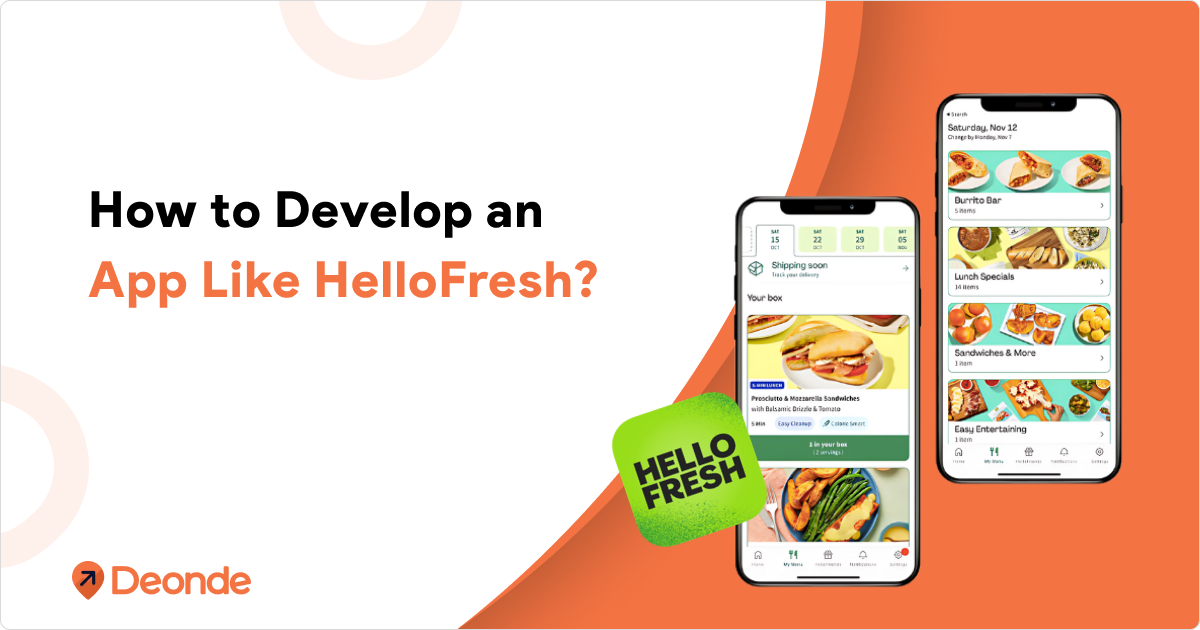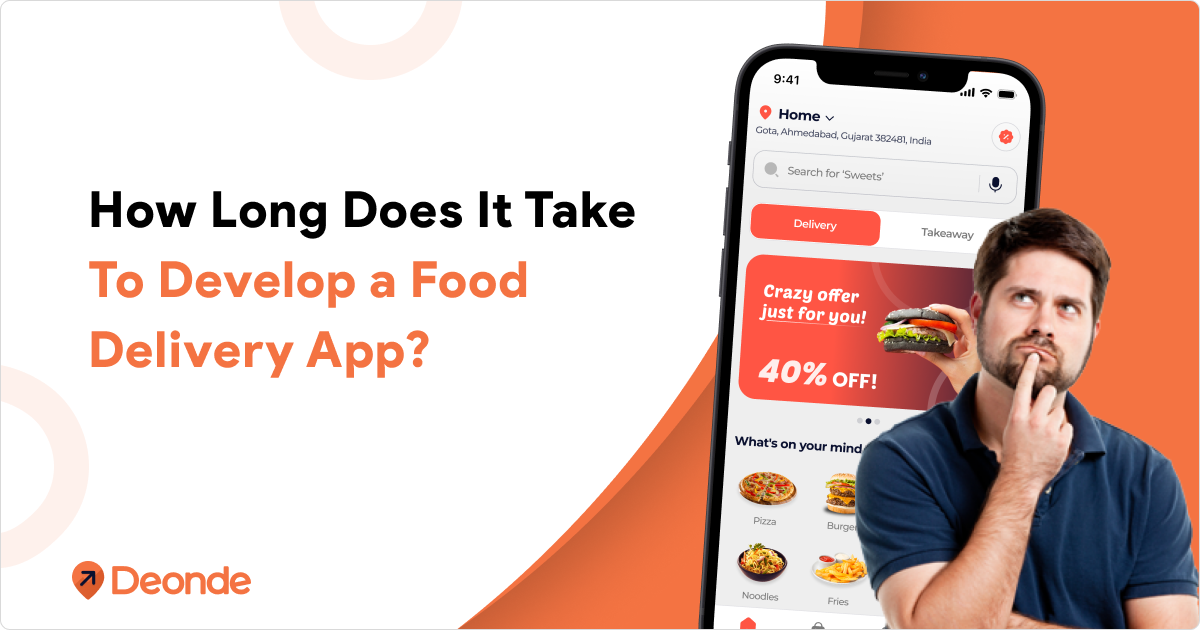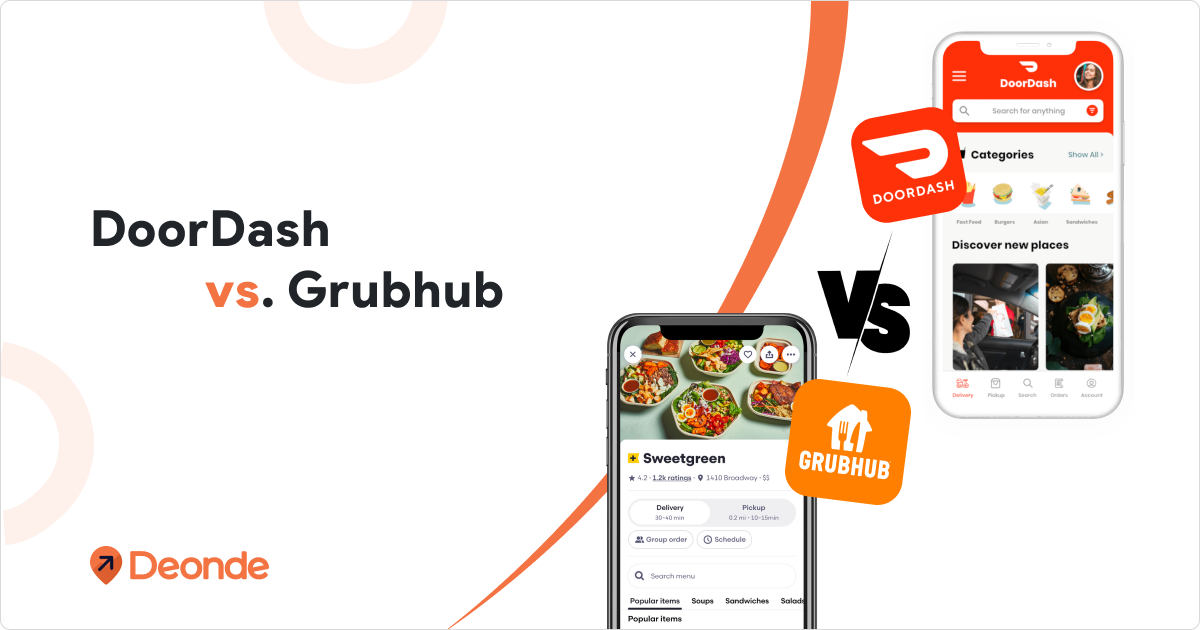What’s for dinner? It’s a question that plagues busy individuals and families every evening. Between packed schedules, limited time, and the desire to eat healthily, deciding what to cook can feel overwhelming.
Enter HelloFresh. This meal kit delivery giant has redefined how people plan, prepare, and enjoy their meals. With pre-portioned ingredients and chef-curated recipes, HelloFresh has grown into a globally recognized brand, blending convenience with nutrition and taste. Their success is rooted in a clear business model, a scalable platform, and a seamless user experience.
In this blog post, we’ll break down exactly what it takes to build an app like HelloFresh. From features and tech stack to market opportunities and development costs, you’ll gain a complete roadmap for launching a successful meal kit delivery app.
What Exactly is a Meal Kit Delivery App?
A meal kit delivery app connects customers with curated recipes and pre-measured ingredients delivered to their doorstep. Think of it as a personal chef meets grocery store, minus the hassle.
Users browse meal options, customize their plans, and schedule deliveries through the app. The app handles everything—ordering, payments, and logistics—while suppliers and kitchens ensure fresh ingredients arrive on time.
HelloFresh, Blue Apron, and Sunbasket are prime examples. These apps cater to busy professionals, families, and health-conscious folks who want home-cooked meals without the stress of planning.
Why Build a Meal Kit App?
Life is hectic, and convenience is king. Meal kit apps save time by eliminating grocery runs and meal planning. Customers love the ease of cooking without the mental load.
Demand for healthy, easy meals is skyrocketing. The meal kit delivery market is primarily divided between subscription-based and on-demand models. Subscription services accounted for 65.9% of the market share in 2024.
The subscription model is a goldmine. Recurring revenue ensures steady cash flow, while flexible plans keep customers hooked. HelloFresh reported €7.66 billion in revenue in 2024, proving the model’s strength.
The market is ripe for disruption. According to Statista, the global meal kit market is projected to hit $20 billion by 2027, with a 12% annual growth rate. Niche markets like vegan, keto, or kid-friendly kits are untapped opportunities.
Key Steps to Develop a Meal Kit App Like HelloFresh

Market Research & Niche Identification
Start by understanding your audience. Are you targeting busy moms, fitness buffs, or eco-conscious eaters? Survey potential users to uncover their pain points.
Analyze competitors like HelloFresh, Gousto, or Marley Spoon. What do they do well? Where do they fall short? Look for gaps—maybe gluten-free kits or budget-friendly plans.
Use tools like Google Trends or SEMrush to spot rising food trends. For example, plant-based diets are booming, with searches up 25% year-over-year.
Business Model & Strategy
Your business model is the backbone of your app. Here’s how to structure it:
-
Subscription Tiers
Offer flexible plans—weekly, bi-weekly, or monthly. Let users choose meal counts (2-6 meals) and serving sizes (2-4 people). Add premium options like organic or chef-special meals.
-
Pricing
Price competitively. HelloFresh charges $7-$10 per serving, plus shipping. Factor in ingredient costs, packaging, and delivery when setting your rates. Offer discounts for first-time users.
-
Supplier Relationships
Partner with local farms, wholesalers, or specialty suppliers for fresh ingredients. Negotiate bulk deals to keep costs low. Ensure suppliers can scale as you grow.
-
Delivery Network
Logistics are critical. Partner with reliable couriers like FedEx or local delivery services. Optimize routes to reduce costs and ensure timely deliveries.
Feature Prioritization (MVP—Minimum Viable Product)
Start with a Minimum Viable Product (MVP) to test your concept without incurring significant costs. Core features for your MVP should include:
- User registration and profiles
- Menu browsing and customization
- Subscription management
- Payment processing
- Delivery tracking
Focus on features that solve the core problem—making meal planning and cooking effortless. Add bells and whistles (like AI recipe suggestions) later.
What tech stack is needed for a food delivery app?
A robust tech stack is crucial for a scalable and high-performing app. This typically involves
- Frontend: React Native or Flutter for cross-platform development (iOS and Android) or Swift/Kotlin for native development.
- Backend: Node.js, Python (Django/Flask), Ruby on Rails, or Java (Spring Boot) for server-side logic and APIs.
- Database: PostgreSQL, MongoDB, or MySQL for data storage.
- Cloud Hosting: AWS, Google Cloud Platform, or Microsoft Azure for scalability and reliability.
- Payment Gateway: Stripe, PayPal, or other secure payment processors.
- Mapping & Location: Google Maps API or similar for delivery tracking.
Top Pick : How to Choose the Right Tech Stack for Your Food Delivery App?
Design & User Experience (UX/UI)
Your app must be a joy to use. Here’s how:
- Intuitive, Visually Appealing: Use clean layouts, vibrant food images, and a cohesive color scheme. HelloFresh’s app feels inviting—emulate that vibe.
-
Easy Navigation: Simplify the user journey. Let users browse meals, adjust plans, and track orders in a few taps. Test prototypes with real users to iron out kinks.
Development & Testing
Break the project into sprints, tackling one feature set at a time. This keeps things manageable and adaptable.
-
Agile Methodology: Work in 2-week cycles, delivering small updates. Collaborate closely with developers, designers, and stakeholders to stay aligned.
-
Thorough QA: Test rigorously for bugs, crashes, and UX issues. Use tools like Selenium for automated testing and real-user feedback for manual checks. Ensure the app handles peak loads during holidays.
Marketing & Launch
A great app needs a great launch. Build hype early.
-
Pre-Launch Buzz: Tease your app on social media, food blogs, and newsletters. Offer early-bird discounts to attract sign-ups.
-
Targeted Advertising: Run ads on Instagram, TikTok, and Google Ads, targeting foodies, busy parents, and health enthusiasts..
-
Partnerships: Team up with influencers, fitness coaches, or local chefs to promote your app. Sponsor cooking events or podcasts to reach niche audiences.
Post-Launch: Iteration & Scaling
Your work doesn’t stop at launch. Use analytics to track user behavior.
-
Gather Feedback: Send surveys or use in-app prompts to collect user input. Fix pain points fast—slow delivery or bland recipes can tank retention.
-
Add New Features: Introduce loyalty programs, gift cards, or meal prep tips based on user demand. Stay ahead of trends like sustainability or zero-waste packaging.
-
Expand Geographically: Start in one city, then scale to new regions. Study local tastes and logistics before expanding. HelloFresh started in Berlin before going global.
Essential Features for Your HelloFresh Alternative
To compete with HelloFresh, your app needs standout features. Here’s what to include:
Customer App
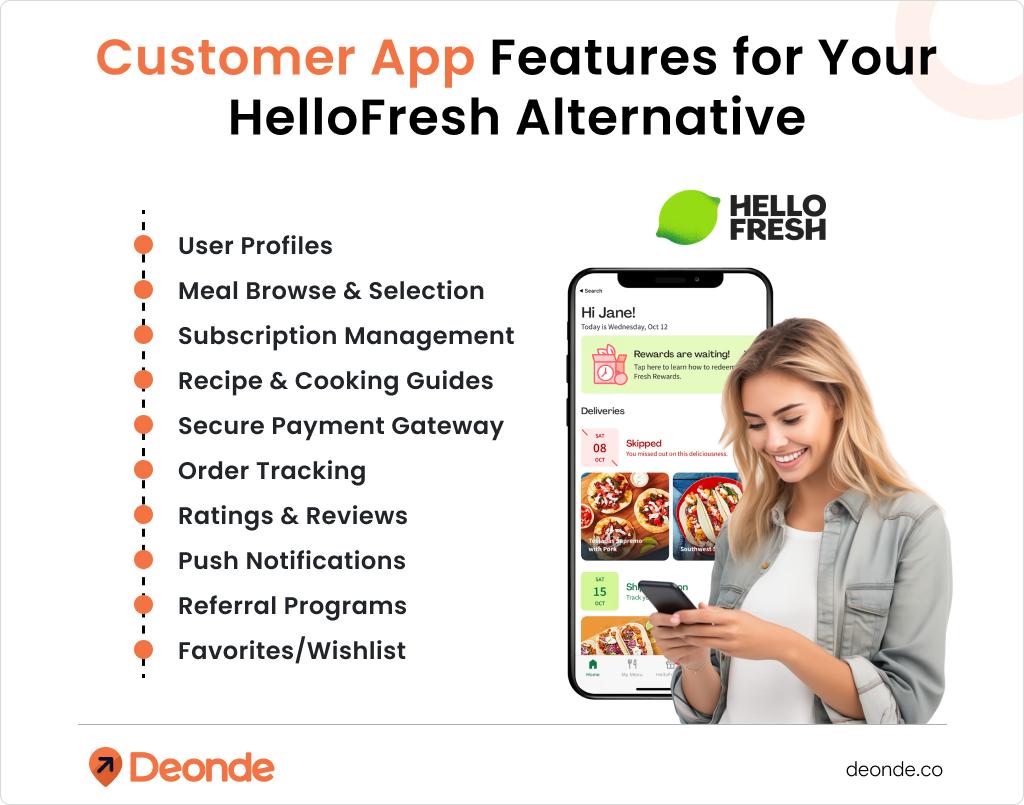
- User Profiles: Personalized dashboards, dietary preferences, saved addresses, order history.
- Meal Browse & Selection: Detailed meal descriptions, high-quality images, filtering by cuisine, dietary needs (vegetarian, vegan, gluten-free), cook time, calorie count.
- Subscription Management: Easy plan changes, meal skips, delivery date adjustments, pause/cancel subscription options.
- Recipe & Cooking Guides: Step-by-step instructions with images/videos, nutritional information, cooking tips.
- Secure Payment Gateway: Multiple payment options (credit/debit cards, digital wallets), auto-renewal setup.
- Order Tracking: Real-time updates on order status (packed, out for delivery, delivered).
- Customer Support: In-app chat, FAQ section, direct contact options (phone/email).
- Ratings & Reviews: Ability to rate meals and provide feedback.
- Push Notifications: Alerts for order confirmations, delivery updates, new recipes, promotional offers.
- Referral Programs: Incentivize users to invite friends and family.
- Favorites/Wishlist: Save preferred recipes for future orders.
Driver App
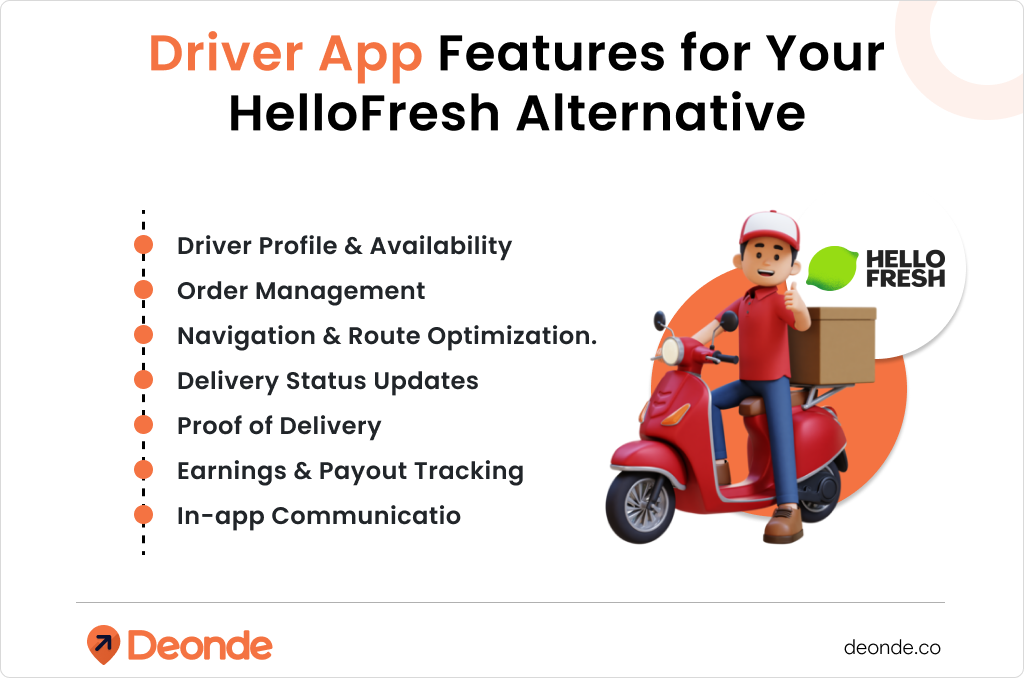
- Driver Profile & Availability: Manage personal details, set availability for deliveries.
- Order Management: View assigned deliveries, details of customer and order.
- Navigation & Route Optimization: Integrated GPS for efficient routes.
- Delivery Status Updates: Mark orders as picked up, delivered, or any issues encountered.
- Proof of Delivery: Option for customer signature or photo verification.
- Earnings & Payout Tracking: View earnings, payment history.
- In-app Communication: Chat/call with customers or admin support.
Merchant App (or internal tool for your kitchen/packaging team)
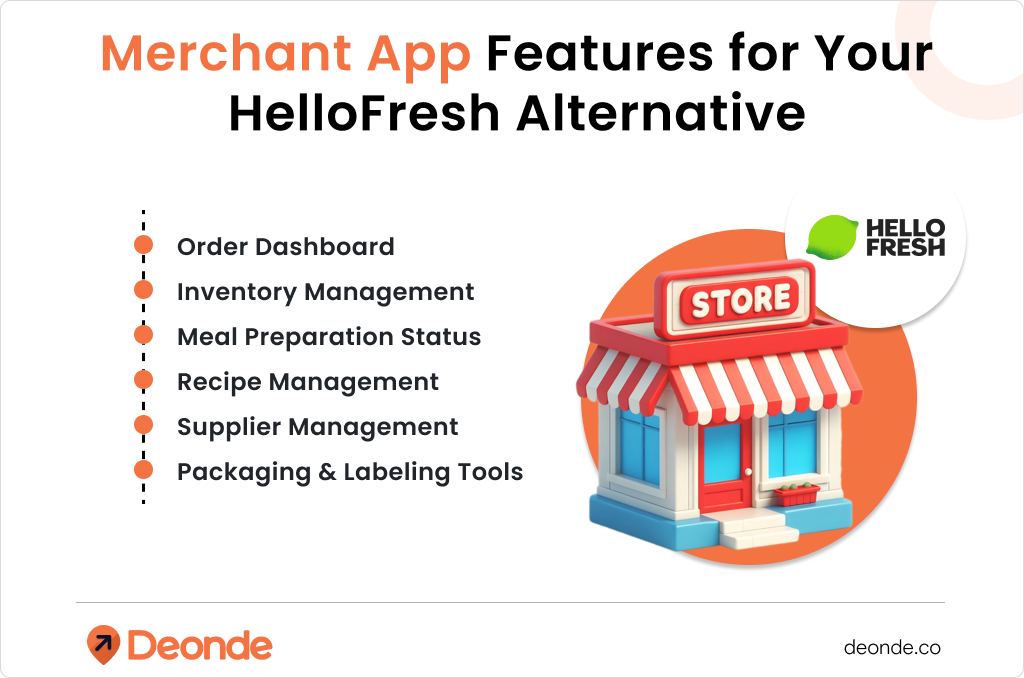
- Order Dashboard: Overview of incoming and pending orders.
- Inventory Management: Track ingredient stock, receive alerts for low stock.
- Meal Preparation Status: Update the status of meal kits (e.g., ingredients pulled, packed).
- Recipe Management: Access to all recipes, ingredient lists, and portioning guidelines.
- Supplier Management: Track incoming deliveries from suppliers.
- Packaging & Labeling Tools: Generate shipping labels and packing slips.
Admin Dashboard
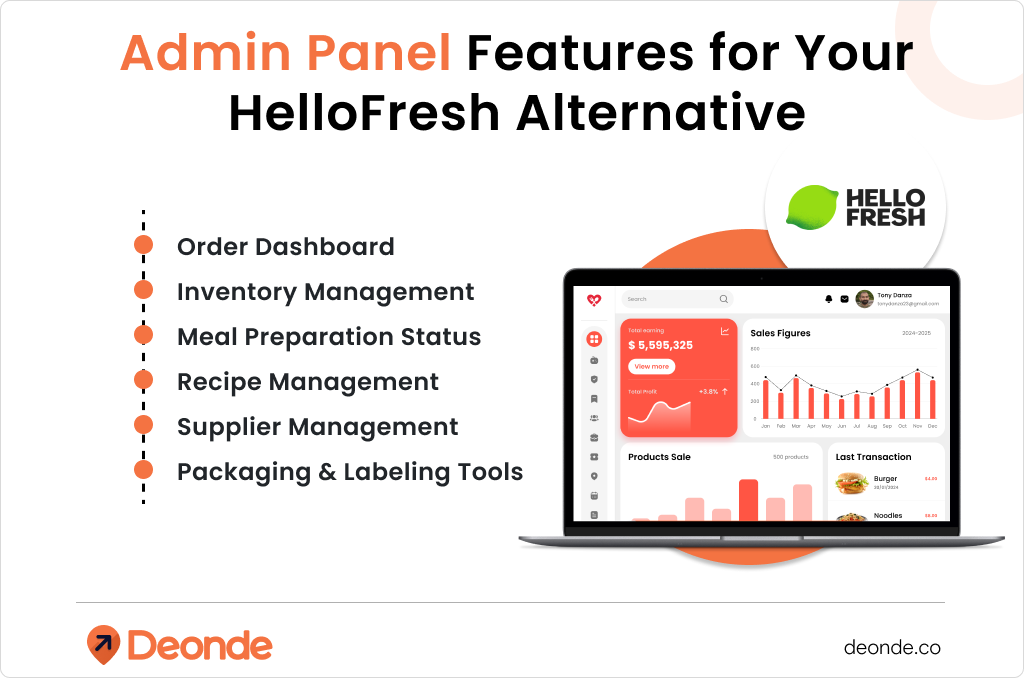
- User Management: Manage customer, driver, and (if applicable) merchant accounts.
- Order Management: Oversee all orders, track their status, resolve issues.
- Menu & Recipe Management: Add/edit/remove meals, update recipes, manage dietary tags.
- Subscription & Billing Management: Handle subscriptions, process refunds, manage payment issues.
- Delivery & Logistics Management: Monitor delivery routes, assign drivers, track fleet.
- Inventory & Supply Chain Management: Centralized view of ingredient stock, supplier performance.
- Customer Support Module: Manage customer queries, feedback, and complaints.
- Analytics & Reporting: Sales data, customer retention rates, popular meals, operational efficiency reports.
- Marketing & Promotions: Create and manage discount codes, special offers, and loyalty programs.
- Content Management: Update blog posts, FAQ, terms & conditions.
How Much Does it Cost to Build an App Like HelloFresh?
Cost is a big question when planning to develop an app like HelloFresh. It depends on features, team size, and location. Here’s a breakdown:
- Market Research: $5,000-$10,000. Competitor analysis, user surveys, and trend research take time and expertise.
- UX/UI Design: $10,000-$20,000. Creating wireframes, prototypes, and a visually appealing interface requires skilled designers.
- Development: $50,000-$150,000. This covers frontend (React Native/Flutter), backend (Node.js/Django), and APIs. Complex features like AI meal suggestions or real-time tracking push costs toward the higher end.
- Testing: $5,000-$15,000. Quality assurance (QA) involves manual and automated testing to catch bugs. User testing ensures a smooth experience.
- Marketing: $10,000-$50,000. Pre-launch ads, influencer campaigns, and PR efforts build buzz.
- Maintenance: $10,000-$30,000/year. Server hosting (AWS/Google Cloud), updates, and bug fixes are ongoing expenses.
Total for Traditional MVP: $90,000-$275,000. Hiring developers in North America or Western Europe is pricier (up to $100/hour) than outsourcing to India or Eastern Europe ($30-$50/hour). Post-launch tweaks (new features, scaling) add 20-30% to the initial cost.
By choosing a SaaS-based solution like Deonde, you can significantly reduce costs and development time while still delivering a high-quality, customized app.
Conclusion: Your Journey to Launching a Successful Meal Kit Service
Developing an app like HelloFresh is a bold move, but the rewards are worth it. Start with solid market research, build a user-friendly MVP, and nail your logistics. Focus on features that solve real problems, like customization and flexibility.
The meal kit market is booming, but success takes grit. You’ll need to balance tech, food, and marketing while keeping customers happy. With the right strategy, your app could be the next big thing in food tech.

